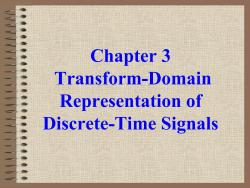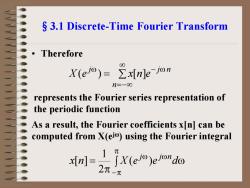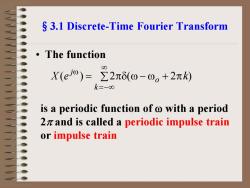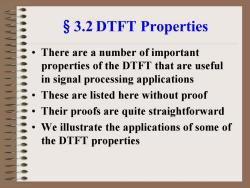电子科技大学:《数字信号处理 Digital Signal Processing》课程教学资源(课件讲稿)Chapter 03 Transform-Domain Representation of Discrete-Time Signals

Chapter 3 Transform-Domain Representation of Discrete-Time Signals
Chapter 3 Transform-Domain Representation of Discrete-Time Signals

S 3.1 Discrete-Time Fourier Transform Definition The Discrete-time Fourier Transform (DTFT)X(ei)of a sequence x[n]is given by X(eo)=∑x[nle-jon n=-∞ In general,X(ei)is a complex function of the real variable o and can be written as X(ei)=Xre(ei)+jXim(ei)
§3.1 Discrete-Time Fourier Transform • Definition - The Discrete-time Fourier Transform (DTFT) X(ejω) of a sequence x[n] is given by ∑ ∞ =−∞ − = n j j n X e x n e ω ω ( ) [ ] X(ejω) = Xre(ejω) + j Xim(ejω) In general, X(ejω) is a complex function of the real variable ω and can be written as

3.1 Discrete-Time Fourier Transform X(ei)can alternately be expressed as X(ei)=X(ei)ei() where ()argx(ei)} X(ei)is called the magnitude function 0()is called the phase function Both quantities are,again,real functions of o In many applications,the DTFT is called the Fourier spectrum Likewise,X(ei)|and 0(@)are called the magnitude and phase spectra
§3.1 Discrete-Time Fourier Transform • X(ejω) can alternately be expressed as X(ejω) = | X(ejω) |ejθ(ω) where θ(ω) = arg{X(ejω) } • | X(ejω) | is called the magnitude function • θ(ω) is called the phase function • Both quantities are, again, real functions of ω • In many applications, the DTFT is called the Fourier spectrum • Likewise, | X(ejω) | and θ(ω) are called the magnitude and phase spectra

S 3.1 Discrete-Time Fourier Transform The DTFT X(ei)of a sequence x[n]is a continuous function of It is also a periodic function of o with a period2π: X(eo+2xk))=xnle-j(0o+2rk)n 2 x[nJe-j”eJ2πkm=2x[n]]e-Jo"=X(e/oo n=-o
§3.1 Discrete-Time Fourier Transform • The DTFT X(ejω) of a sequence x[n] is a continuous function of ω • It is also a periodic function of ω with a period 2π: = ∑ ∞ =−∞ ω + π − ω + π n j o k j o k n X e x n e ( 2 ) ( 2 ) ( ) [ ] j kn n j n x n e e o − π ∞ =−∞ − ω = ∑ 2 [ ] [ ] ( ) o o j n j n x n e X e ω ∞ =−∞ − ω = ∑ =

3.1 Discrete-Time Fourier Transform Therefore X(ef)=xInle-jon n=-o0 represents the Fourier series representation of the periodic function As a result,the Fourier coefficients x[n]can be computed from X(ei)using the Fourier integral al2iemema
§3.1 Discrete-Time Fourier Transform • Therefore = ∑ ∞ =−∞ ω − ω n j j n X (e ) x[n]e ∫ ω π = π −π ω ω x n X e e d j j n ( ) 2 1 [ ] As a result, the Fourier coefficients x[n] can be computed from X(ejω) using the Fourier integral represents the Fourier series representation of the periodic function

3.1 Discrete-Time Fourier Transform Inverse Discrete-Time Fourier Transform: ]-X(el)eordo
§3.1 Discrete-Time Fourier Transform • Inverse Discrete-Time Fourier Transform: ∫ ω π = π −π ω ω x n X e e d j j n ( ) 2 1 [ ]

3.1 Discrete-Time Fourier Transform A Dirac delta function 8(@)is a function of o with infinite height,zero width,and unit area It is the limiting form of a P4() unit area pulse function Pa(o)as△goes to zero satisfying 0 0 00 2 △2 lim ∫p4(o)do=∫δ(o)do →0
§3.1 Discrete-Time Fourier Transform • A Dirac delta function δ(ω) is a function of ω with infinite height, zero width, and unit area ∫ ω ω = ∫ δ ω ω ∞ −∞ ∞ −∞ → ∆ ∆ lim p ( )d ( )d 0 ω 2 ∆ − 2 0 ∆ ∆ 1 (ω) ∆p • It is the limiting form of a unit area pulse function p∆(ω) as ∆ goes to zero satisfying

3.1 Discrete-Time Fourier Transform The function X(eo)=∑2πδ(o-0,+2元k) k=-00 is a periodic function of o with a period 2 and is called a periodic impulse train or impulse train
§3.1 Discrete-Time Fourier Transform is a periodic function of ω with a period 2π and is called a periodic impulse train or impulse train = ∑ πδ ω−ω + π ∞ =−∞ ω k o j X (e ) 2 ( 2 k) • The function

Commonly Used DTFT Pairs Sequence DTFT [n] ←> 1 1 > ∑2πδ(Q+2元k) k=-00 00 > ∑2πδ(0-0,+2πk) k=-00 1 00 K> +∑πδ(O+2πk) 1-e-jo k=-00 1 a"4nl,(<1) 1-ae-jo
Commonly Used DTFT Pairs Sequence DTFT δ[n] ↔ 1 ↔ ∑ πδ ω+ π ∞ k=−∞ 1 2 ( 2 k) ↔ ∑ πδ ω−ω + π ∞ =−∞ ω k o j n e k o 2 ( 2 ) + ∑πδ ω+ π − µ ↔ ∞ =−∞ − ω k j k e n ( 2 ) 1 1 [ ] ω α α µ α j n e n − − < ↔ 1 1 [ ], ( 1)

§3.2 DTFT Properties There are a number of important properties of the DTFT that are useful in signal processing applications These are listed here without proof Their proofs are quite straightforward We illustrate the applications of some of the DTFT properties
§3.2 DTFT Properties • There are a number of important properties of the DTFT that are useful in signal processing applications • These are listed here without proof • Their proofs are quite straightforward • We illustrate the applications of some of the DTFT properties
按次数下载不扣除下载券;
注册用户24小时内重复下载只扣除一次;
顺序:VIP每日次数-->可用次数-->下载券;
- 电子科技大学:《数字信号处理 Digital Signal Processing》课程教学资源(课件讲稿)Chapter 02 Discrete-Time Signals and Systems.pdf
- 电子科技大学:《数字信号处理 Digital Signal Processing》课程教学资源(课件讲稿)Chapter 01 Continuous-time Signals and Systems.pdf
- 电子科技大学:《数字信号处理 Digital Signal Processing》课程教学资源(课件讲稿)Chapter 00 Introduction.pdf
- 电子科技大学:《微电子器件》课程教学资源(思政教案)高频晶体管设计.pdf
- 电子科技大学:《微电子器件》课程教学资源(思政教案)MOSFET发展方向.pdf
- 电子科技大学:《微电子器件》课程教学资源(思政教案)大注入效应.pdf
- 电子科技大学:《微电子器件》课程教学资源(思政教案)绪论、微电子技术发展现状.pdf
- 电子科技大学:《微电子器件》课程教学资源(教学大纲)Microelectronic Devices.pdf
- 电子科技大学:《移动通信系统》课程教学资源(课件讲稿)第七章 未来移动通信系统及其增强技术.pdf
- 电子科技大学:《移动通信系统》课程教学资源(课件讲稿)第四章 抗衰落和链路性能增强技术.pdf
- 电子科技大学:《移动通信系统》课程教学资源(课件讲稿)第六章 GSM及其增强移动通信系统.pdf
- 电子科技大学:《移动通信系统》课程教学资源(课件讲稿)第五章 蜂窝组网技术(移动通信网的基本概念、频率复用和蜂窝小区、多址接入技术).pdf
- 电子科技大学:《移动通信系统》课程教学资源(课件讲稿)第二章 移动通信电波传播与传播预测模型.pdf
- 电子科技大学:《移动通信系统》课程教学资源(课件讲稿)第三章 移动通信中的信源编码和调制解调技术.pdf
- 电子科技大学:《移动通信系统》课程教学资源(课件讲稿)第一章 概述(主讲:雷霞).pdf
- 电子科技大学:《移动通信系统》课程教学资源(授课电子教案,雷霞).pdf
- 电子科技大学:《移动通信系统》课程教学资源(思政案例选录).pdf
- 电子科技大学:《移动通信系统》课程教学资源(教学大纲)Mobile Communication System.pdf
- 电子科技大学:《白话通信与计算 Introduction to Communications and Computations》课程教学资源(课件讲稿)04 多址接入与功率控制.pdf
- 电子科技大学:《白话通信与计算 Introduction to Communications and Computations》课程教学资源(课件讲稿)03 网络OSI分层结构.pdf
- 电子科技大学:《数字信号处理 Digital Signal Processing》课程教学资源(课件讲稿)Chapter 04 Frequency-domain Representation of LTI Discrete-Time Systems.pdf
- 电子科技大学:《数字信号处理 Digital Signal Processing》课程教学资源(课件讲稿)Chapter 05 Digital Processing of Continuous-Time Signals.pdf
- 电子科技大学:《数字信号处理 Digital Signal Processing》课程教学资源(课件讲稿)Chapter 06 Digital Filter Structures.pdf
- 电子科技大学:《数字信号处理 Digital Signal Processing》课程教学资源(课件讲稿)Chapter 07 Digital Filter Design.pdf
- 电子科技大学:《数字信号处理 Digital Signal Processing》课程教学资源(课件讲稿)Chapter 09 Analysis of Finite Wordlength Effects.pdf
- 电子科技大学:《数字信号处理 Digital Signal Processing》课程教学资源(课件讲稿)Chapter 10 Multirate Digital Signal Processing.pdf
- 电子科技大学:《数字信号处理 Digital Signal Processing》课程教学资源(课件讲稿)Chapter 11 Applications of Digital Signal Processing.pdf
- 电子科技大学:《数字通信基础 Digital Communications》课程教学资源(课件讲稿,图片版)About.pdf
- 电子科技大学:《数字通信基础 Digital Communications》课程教学资源(课件讲稿,图片版)Chapter 01 Introduction 1.1 Exampls.pdf
- 电子科技大学:《数字通信基础 Digital Communications》课程教学资源(课件讲稿,图片版)Chapter 01 Introduction 1.2 Diagram and elements of Comm.Sys.pdf
- 电子科技大学:《数字通信基础 Digital Communications》课程教学资源(课件讲稿,图片版)Chapter 01 Introduction 1.3 Digital Comm.Sys.pdf
- 电子科技大学:《数字通信基础 Digital Communications》课程教学资源(课件讲稿,图片版)Chapter 01 Introduction 1.4 Channels and their characteristics.pdf
- 电子科技大学:《数字通信基础 Digital Communications》课程教学资源(课件讲稿,图片版)Chapter 04 Information source and source coding 4.1 ADC and PCM.pdf
- 电子科技大学:《数字通信基础 Digital Communications》课程教学资源(课件讲稿,图片版)Chapter 04 Information source and source coding 4.2 Modeling of digital source.pdf
- 电子科技大学:《数字通信基础 Digital Communications》课程教学资源(课件讲稿,图片版)Chapter 05 Digital transmission through the AWGN channel 5.1 Geometric rep.of the sig waveforms.pdf
- 电子科技大学:《数字通信基础 Digital Communications》课程教学资源(课件讲稿,图片版)Chapter 05 Digital transmission through the AWGN channel 5.2 Pulse amplitude modulation.pdf
- 电子科技大学:《数字通信基础 Digital Communications》课程教学资源(课件讲稿,图片版)Chapter 05 Digital transmission through the AWGN channel 5.3 2-d signal waveforms.pdf
- 电子科技大学:《数字通信基础 Digital Communications》课程教学资源(课件讲稿,图片版)Chapter 05 Digital transmission through the AWGN channel 5.4 M-d signal waveforms.pdf
- 电子科技大学:《数字通信基础 Digital Communications》课程教学资源(课件讲稿,图片版)Chapter 05 Digital transmission through the AWGN channel 5.5 Opt.reception for the sig.in AWGN.pdf
- 电子科技大学:《数字通信基础 Digital Communications》课程教学资源(课件讲稿,图片版)Chapter 05 Digital transmission through the AWGN channel 5.5.2 Opt.reception for the sig.in AWGN.pdf
